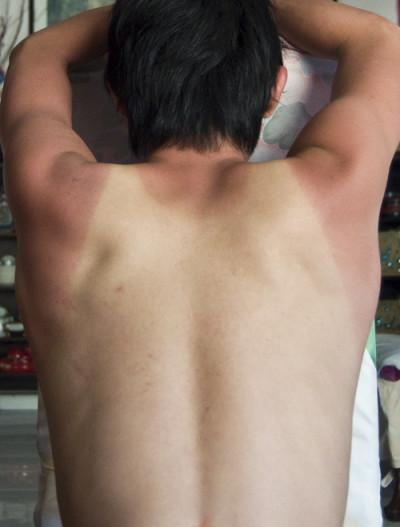The annals of medicine are replete with examples where the accepted consensus of medical opinion has been revised or even completely reversed. Do I need remind you that arsenic, mercury, heroin and tobacco were all regularly prescribed by nineteenth century physicians for their “medicinal” value? That’s the reason that Spanking FIT strongly holds to its philosophy that all “expert” opinion must be carefully scrutinized. In our current segment, we carefully examine the opinion firmly held by many contemporary medical practitioners: sunshine exposure is the primary cause of skin cancer, and sunscreen or sunblock protects us from it.
In “Male with Low T? Try Nude Sunbathing!“, December 2014, Spanking FIT discussed the benefits of practicing sunbathing nude which we attributed mainly to the Vitamin D /sunshine connection. We performed an independent meta-analysis of published clinical trial results that provided stronger evidence in support of claim that vitamin D may significantly lower cancer risk in both women and men. We went on to uncover a potential link between vitamin D and testosterone production that may provide a safer alternative to pharmaceutical products for men wishing to increase their “T-levels”, naturally.
In “Nude Sun Bathing- It Does a Body Good!“, August 2015, Spanking FIT presented scientific evidence that moderate sunshine exposure may provide a safe and natural way for women and men to also increase their serum Insulin-like Growth Factor (IGF-1) levels. IGF-1 is a naturally produced protein which helps build the body and which may protect against cancer.
Despite a plethora of potential health benefits, everyone is aware of warnings originating from medical “authorities” that sunshine exposure presents a risk of skin cancer, especially for fair-skinned individuals, and that it is crucial that sunblock or sunscreen be applied for protection. Let’s begin with a summary of these warnings and their sources:
Common warnings regarding sunshine and skin cancer, & their sources
(1) American Cancer Society (A.C.S.)
According to their website cancer.org, “most skin cancers are caused by too much exposure to ultraviolet rays. Most of this exposure comes from the sun. U.V. rays damage the D.N.A. of skin cells. Skin cancers start when this damage affects the D.N.A. of genes that control skin cell growth.” They claim that “similar” gene “transitions” have been observed in pre-malignant skin tumors. They fail to mention that a healthy human immune system has ability to repair D.N.A. damage, and that there is a strong connection between sunshine and cutaneous vitamin D3 production which is potentially protective against skin cancer. Nevertheless, their over-load theory sounds plausible. Unfortunately, their reference section contains no experimental work validating their opinions which we could review.
(2) U.S. Centers for Disease Control (C.D.C)
Their website, cdc.gov, states that most cases of the more serious type of skin cancer, malignant melanoma, are “caused by exposure to Ultra Violet light, and that the causal relationship between U.V. exposure and skin cancer among populations with comparatively more sensitive skin is well-established.” It further states that “recent genetic research has found a U.V. exposure “signature” among mutations specific to melanoma.” Again, absent in their reference section is experimental work that confirms this theory which we could review.
(3) U.S. National Institute of Health-National Cancer Institute (N.C.I.)
This opinion source is much less definitive regarding alleged causality between sunshine exposure and skin cancer. Their website, cancer.gov, states: “some studies suggest that being exposed to ultra violet radiation and the sensitivity of one’s skin are risk factors for skin cancer.” However, they also state that “it is not known if using sunscreens, staying out of the sun, or wearing protective clothing actually lowers the risk of non-melanoma or melanoma skin cancer.”
Interesting isn’t it how some medical “experts” seem to “know” the answer, while others are less certain. We digress at this point to note that in 2013 alone, a year for which data is available, sun protection products generated $5.6 billion in sales, and that the Skin Cancer Foundation (S.C.F.) which supplies substantial information to dermatologists, is heavily supported by the sunblock and sunscreen industry. (Check out their web site skincancer.org.)
(4) World Health Organization (W.H.O.)-Environmental Burden of Disease Series (No. 13)
In this voluminous work, W.H.O. scientists claim to have realistically estimated that there were 65,154 deaths world wide due to Malignant Melanoma (M.M.) in the year 2,000, and 13, 535 deaths due to Squamous Cell Carcinoma (S.C.C.) (The estimated world population was 6,100,000,000 that year) Of the fatalities, W.H.O. estimates that as many as 58,645 M.M. fatalities or approximately 90% are attributable to U.V. exposure, and that as many as 9,474 S.C.C. fatalities or 70% are attributable to same cause. No estimates of how many possible cancers due to inadequate sunshine exposure and inadequate vitamin D levels are given. In contrast to the above sources, W.H.O. gave many references which Spanking FIT could examine from the perspective of statistical validity. We present the principal results of that review:
References asserting causality between UV exposure & skin cancer
(1) “Case-control study of sun exposure & squamous cell cancer (S.C.C.)” by D. English et al., published in International Journal of Cancer 1998;77(3), 347-353.
In a case control study, a group of patients having a particular disease is compared with a group that does not (“controls”) by looking back retrospectively. Comparisons are made regarding how frequently a certain “risk exposure” was in each group. In this detailed Australian study, 132 confirmed cases of S.C.C. were compared with 1,031 controls. All the selected subjects were of similar fair skin tone. A major weakness of this study, which was acknowledged by its authors, was that individual sun exposure estimates were based on subject interviews and relied on their ability to accurately recollect lifetime sun exposure patterns; e.g., how much time they spent outdoors, how much sun block was used, etc.
From a statistical perspective, sample sizes used were probably insufficient; since, reported risk estimates or “odds ratios”were not significant at conventional levels. (Not significant means large possibility of being obtained just by chance.) While this study may be useful as a pilot study in designing future experiments, it should not in itself be the basis for drawing conclusions regarding the sunshine/skin cancer hypothesis, in my opinion, as W.H.O. did.
(2) “The relationship between ultraviolet light exposure and incidence of skin cancer” by J.E. Moan, et al. published in Photodermatology Photoimmunology Photomedicine; Jan. 31, 2015; (1) 26-35.
The W.H.O. study cited prior work by same author, so, naturally, Spanking FIT preferred to review his most recent work. Moan utilized incidence rate data from the Norwegian Cancer Registry and the Association of Nordic Cancer Registries (NORDCAN). U.V. exposure was derived from the Norwegian U.V. monitoring network for several regions of the country. Using statistical regression tools, the researchers reported a mathematical power law relationship between cancer incidence rate per square centimeter of body area and U.V. exposure, in the case of both malignant melanoma and S.C.C. For S.C.C., they reported incidence rate differences based on body location, with the heavily exposed head having a higher rate than the less exposed neck and trunk. This was not the case for malignant melanoma. Rates did not differ based on body location. The latter finding they presented as evidence that intermittent, rather than continuous, sun exposure is causal for malignant melanoma.
Unfortunately, this study also suffers from several statistical flaws. I realize that most readers are not statisticians; but, I state them anyway: the bivariate normal parametric requirement cannot be explored adequately due to small sample sizes used, and the requirement of homoscedasticity may be violated based on visual inspection of their published graphs.
While Spanking FIT did not review every research reference offered by W.H.O. as supporting the sunshine/ skin cancer hypothesis, the many which we did review all contained defects similar to those cited above in (1) and (2). In addition, keep in mind that for every study published which asserts weak causality, there may be many studies where causality was not found that consequently went unpublished.
Research asserting a lack of causality between U.V. exposure & skin cancer, or the opposite
(1) “Exponentially increasing incidence of cutaneous malignant melanoma in Europe correlates with low personal U.V. doses_” by S. J. Merrill, et al. published in Dermatoendocrinology; Feb. 2015, 7(1)
This study, focusing on European countries, used cutaneous malignant melanoma (C.M.M.) incidence data from the International Agency for Research on Cancer (I.A.R.C.). They derived average annual personal U.V. doses for each country using a methodology based on population centered latitudes. The researchers reported a downward trend between the C.M.M. incidence rate and U.V. dose for those European nations inhabited by fair-skinned people (Type I or II Fitzpatrick skin type). While the authors acknowledge that U.V. exposure may initiate C.M.M., they postulated that the lower levels of cutaneous Vitamin D3 resulting from lower U.V.B. exposure, in combination with sunshine activated viral agents such as H.P.V. , is the true cause of C.M.M. in humans, and not sun over-exposure or sun burn. One implication of this is that over-use of sunblock may actually promote melanoma. (The authors make a note that C.M.M. incidence rates have been observed to be increasing exponentially over time in parallel with the increased use by the public of sunscreens offering enhanced “protection” from the sun’s rays.)
In examining their results, Spanking FIT made an important observation that was not cited by the researchers: Certain pairs of countries such as Norway and Finland, at approximately the same geographical latitudes, have comparatively high and low C.M.M. rates, respectively. This suggested we focus on Oslo,Norway and Helsinki, Finland. Both are coastal Nordic cities at same latitude with populations of similar skin type; and, presumably with similar habits with respect to sunshine exposure. Spanking FIT used data from NORDCAN on average age standardized incidence rates of cancer to compare the two cities. The results were astounding. Oslo was found to have a 30% higher C.M.M. incidence rate than Helsinki that was also very statistically significant. These findings strongly indicate the existence of presently unknown risk factors for melanoma other than sunshine exposure, at least for the involved populations and the latitudes which they inhabit .
(2) “Ultraviolet light exposure influences skin cancer in association with latitude” by M.Rivas; published in Oncology Reports, April 2011, 25(40)
Chilean researchers compared cancer incidence rates over a period of approximately ten years in two selected cities having an approximate 21 degree difference in latitude: Arica in the north, and more southerly Valdivia. U.V. exposure estimates were based on readings from the Chilean Meteorological Organization network. While researchers reported that the overall skin cancer incidence rate was higher as they expected in sunnier Arica, the complete opposite was the case for deadlier S.C.C. and C.M.M. Their incidence rates were actually lower in sunnier Arica! Their findings are consistent with those reported in (1) above, but from a completely different part of the world.
In conducting my investigation, it became apparent that conflicting evidence exists with regard to the sunshine/ skin cancer hypothesis. Upon reflection, it occurred to me that all investigators had, perhaps, committed a common mistake: Their rate comparisons were based on stable populations that had inhabited the same environment for a prolonged historical period. If the skin cancer/ sunshine exposure is correct, then such populations have undoubtedly evolved their own unique abilities to withstand the deleterious effects of U.V. radiation and utilize its benefits, based on the laws of natural selection. Isn’t it more appropriate to compare incidence rates among fair-skinned people who have recently migrated away from less sunny environments to sunnier ones? But where, if anywhere, has that occurred in recent history? In Australia, of course, when the Brits migrated there in the 19th century!
Using GLOBOCANS world age standardized rates for malignant melanoma, Spanking FIT ascertained that in 2012 the Australian incidence rate was 139% higher in Australia than in the U.K. and, furthermore, that the results were highly statistically significant. (Granted that the percentage of “whites” is estimated to be around 10% lower in U.K. currently than in Australia, this drastic incidence rate difference cannot be explained on the basis of demographics alone.) This is probably the strongest statistic that favors the U.V. exposure/ skin cancer hypothesis in the case of melanoma, in my opinion. (Similar comparisons with S.C.C. rates could not be made due to lack of reporting.) Please keep in mind, however, that observing that a transplanted population with prolonged exposure to U.V. has a higher cancer incidence rate is not the same as saying that it is dangerous for fair-skinned people to take infrequent vacations to sunnier locations.(The inhabitants of Finland apparently safely do so.) This is something that needs to be scientifically explored more fully.
Evidence derived from animal experimentation
Naturally, it would be possible to resolve this puzzle using human clinical data; but, for moral and ethical reasons none exists. So Spanking FIT turned to experimental work with animals. To begin with, melanoma cannot be induced in “natural ” lab mice. All mice where U.R.V. induced melanoma in them, were either genetically modified, or carried mutations. Furthermore, the reported cancers arose after a long latency period, were infrequent, and had limited metastases.(see “Modelling Melanoma in Mice” by G.J. Walker; Pigment Cell Melanoma Research 2011 Dec 24 (6) 1158-76.) That left us with non-melanoma skin cancer, only. The study considered “ground breaking” and most often quoted by dermatological “experts” is “Ultraviolet light and skin cancer” by G.M. Findlay, published in The Lancet in 1928 (212:1070-73). In it, 20 albino mice are exposed to U.V. for approximately eight months. Seven months after start, nine survived and six of them went on to eventually develop tumors. (It was reported that the eleven died of “other causes”.) This was not a well-designed study statistically because sample sizes were small, and researchers did not use a control group for comparative purposes. There were also classification problems with respect to the type of tumors that developed. However, Spanking FIT uncovered a much more serious problem with this study and many others like it. In checking the specifications on the lamp they used, we uncovered that it emitted highly carcinogenic U.V.C., in addition to U.V.A. and U.V.B. Natural sunlight does not contain U.V.C. The same problem existed with another frequently cited animal study on the subject:“Tumor production in mice with U.V. radiation” by H.P. Rusch published in American Journal of Cancer (1939) ;35,55-62.
Conclusions
The firmly held belief by some that sunshine over-exposure is causal for non-melanoma and melanoma skin cancer, while plausible, does not appear scientifically validated to date. In the case of melanoma, evidence exists which contradicts the theory that intermittent exposures and/or sunburns are causal for it. Consequently, it is unknown whether or not brief vacations to sunny locations are hazardous for fair skinned people. On the other hand, the theory that over-use of sunscreen and sunblock products may contribute to melanoma incidence by inhibiting cutaneous vitamin D3 production deserves to be more fully explored. There is, however, evidence that prolonged exposure to high U.V. levels by a population not environmentally adapted to it, may be causal for melanoma. That appears to be the case in Australia.
Stay tuned as more solid experimental results are, hopefully, published in future to assist us. Also, please notify me if you know of any unpublished relevant work. You may contact me at the Spanking FIT contact page. In the meantime, keep enjoying sunbathing nude, and don’t forget to read “Nude Sunbathing- It Does a Body Good!” and give me your feedback on that, too. Thanks a lot. Doctor Garrett





